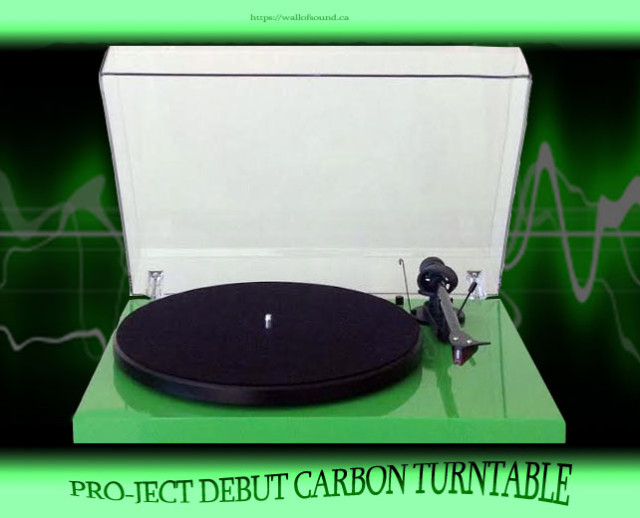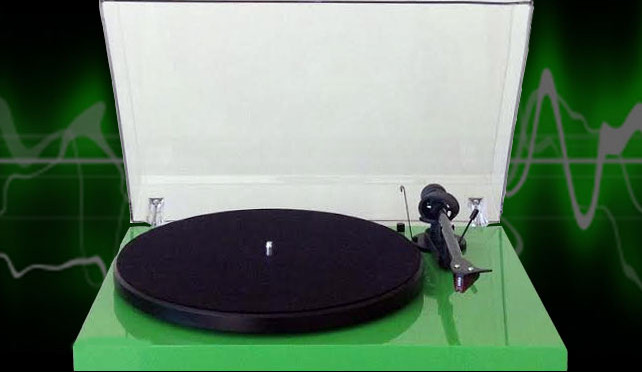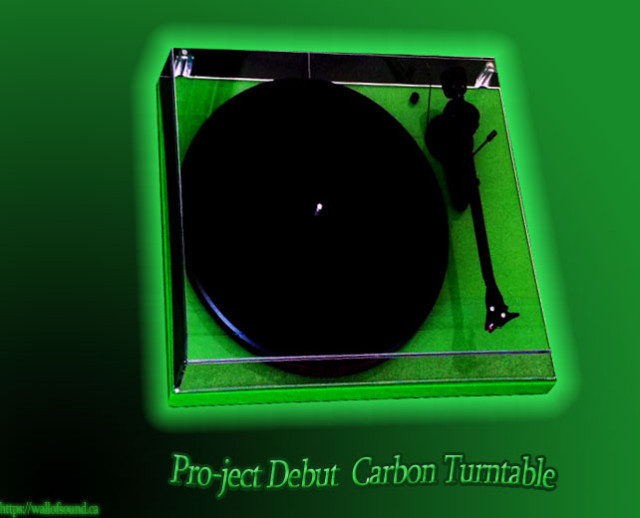One [pretty decent] Way To Skin A Cat

This review could reach a few different potential audiences. But we’ll assume that the reader is likely an aspiring audiophile, and, in that context, this is a budget turntable. That doesn’t reduce my expectations, or make excuses for what is still, for many people, a considerable investment ($400 USD).
Pro-ject Audio Systems has been quietly and efficiently making analog equipment in the EU for many years. It’s basically all they do, and their lineup is vast, by any measure. Is there another company this committed to vinyl LP reproduction today? I can think of several (Ortofon and SME among them), but none that have plug’n’play turntables starting in the $300 range!
The Debut Carbon model comes “fully equipped” with a carbon-fiber tonearm made by Pro-ject, and an Ortofon 2M Red cartridge – itself a multiple award-winner and bargain, that retails for $100. Plug and play? Yes, indeed. The peripherals are pre-installed at the factory, meaning that setup effort is quite low, though not completely eliminated. The geometric work of cartridge alignment is done for you, and that’s huge. What’s left is to balance the tonearm, connect the turntable to your stereo, and enjoy some records. Roughly 5-10 minutes to showtime for someone who’s done it, half an hour at most for a newbie who needs to read the directions (which are quite good). Included is a decent low capacitance phono cable, which includes a ground lead. Since the cable is separate, it can be upgraded later with your choice of suitable interconnect cables. A nice approach.
So let’s get to the important stuff. How well does the Debut Carbon perform?
Pretty darn good. Though the full answer isn’t quite so simple. This is quite a well-made product, obviously made to a price point and designed for ‘mass’ production. It gets the job done and represents fair value in today’s market. It’s well-packaged, and double-boxed for safe transport. Kudos. Music sounds like music, it holds the right speed, and the whole shebang is helped along by the terrific Ortofon, a sweet cartridge which has never played badly in the various systems that I’ve tried it in. The Debut Carbon certainly holds its’ own against competing ‘budget audiophile’ models from Rega, Music Hall, and the like.
For many, this is all the turntable they will ever need or want. It looks great, and is an easy recommendation to make – for a variety of potential buyers. I enjoyed my time with it. However: this deck represents one approach, and I should point out some items that I think could be improved. Really, all of these are in the area of noise isolation.

First off – playing music with the dust cover attached, the vibration-induced feedback was really bad. Dust covers are a common source of vibration issues, and are often removed during use, but with the Debut these resonances are transmitted straight into the stylus and are very audible from your speakers. As you can see in the photos, the hinge design is to blame – the round L-shaped pieces aren’t even real hinges, it’s just a collar arrangement. Regardless of the reasons, I didn’t see any solution apart from removing the cover during play. Not a big deal.
This leaves two areas that may prove to be problematic. Possibly three.
1. The ‘platter’ is really just a thin, flat piece of metal that has simply had its’ outer edge turned down to form the shape of a platter. It rings like nobody’s business, and the felt mat does nothing to quell that. This felt mat arrangement isn’t as slippy as some I’ve seen, but it still should be scrapped for something grippier. Why manufacturers persist with these, I don’t know. They do look smart, and I guess some people like them. As far as the platter, my suggestion would be to try damping it with a few small dabs of Blu Tak. But use very small bits, placed symnetrically so as not to upset the rotational balance (which would cause speed deviation and could eventually strain the motor). Other materials may work, if they’re similar in density and tackiness. The standard nail-flick test should tell you right away if this technique is effective in damping the ringing. A better mat would go a long way, so if all this sounds like a hassle, you could first try just replacing the mat, with a decent rubberized one of the same thickness. I’ll be the first to admit, I’ve heard many turntables with very ring-y platters. that still made music sound great. But with this unit’s design, I’d say the user should be prepared to do some light experimenting.
2. The motor has a bit of self-noise (AC hum), and is coupled to the plinth in such a way that I don’t think does much to mute that noise. All turntables face this issue, and there are a bunch of ways to address it. Again, this may not be objectionable. This level of motor hum won’t be heard unless your ear is within a foot or so of the turntable. But remember, in vinyl playback, even very minute distortions are critical. That’s because the original signal is derived from a vibration – a modulation in the groove. So this tiny signal, along with any aberrations, is multiplied (amplified) by a large factor by the time it reaches the listener. Problems are magnified. The old garbage in, garbage out adage.
Lastly – the feet appear to be decently thought out, but this is a really important part of isolating the deck from local environmental issues. A lightweight ‘table like this is ideally suited for mounting on a good wall shelf, and I would encourage a user to try some Vibrapods, or similar inexpensive mounts. They could make a real audible improvement.
My only other quibble is a minor one; it would have been nice if a speed selector switch could have been included, considering the target audience for this machine. Pro-ject has followed the minimalist approach taken by Linn and Rega over many years, but they’ve at least included a small tool to move the belt to the appropriate pulley notch for switching between 33 and 45rpm.
So there you have it. Would I recommend this turntable to my sister? Absolutely, just with a caveat or two. The Debut Carbon is functional, stylish, and performs well. I see no reason why it shouldn’t be dead reliable. It should be mounted on a wall shelf, in most situations. It certainly comes close to providing an optimal user experience out of the box (plug and play), but needs a bit of help in the areas I’ve mentioned. As such, the user needs to understand some of the dynamics, and needs to “get involved” to an extent. Personally, I think that’s a good thing. I can’t help but wonder about the improvement that is attainable in the Esprit model – the one with the heavier, solid acrylic platter. But that adds around 25% to the price, and invites a look at other competitors, including Project’s own RPM 1.3 ‘Genie’.
As my title caption suggested, there are other ways to approach the budget turntable question. In an upcoming article, I’ll survey some of those, based on used turntables in the $150-300 range.
- Pro-ject Debut Carbon Turntable in green.
views



As an owner of the Debut Carbon, I’ve added a couple of options that may or may not have been available at the time this review was published. First, I replaced the stock metal platter with the acrylic platter. Second and most important, the Speed Box S power supply/speed change attachment. This makes a world of difference in the sound of the Debut Carbon, elevating this turntable to a much higher level. Yes, that also comes with a $260 US price increase, but the added speed stability, speed change, and overall fidelity the ‘table exhibits make the money well-spent.